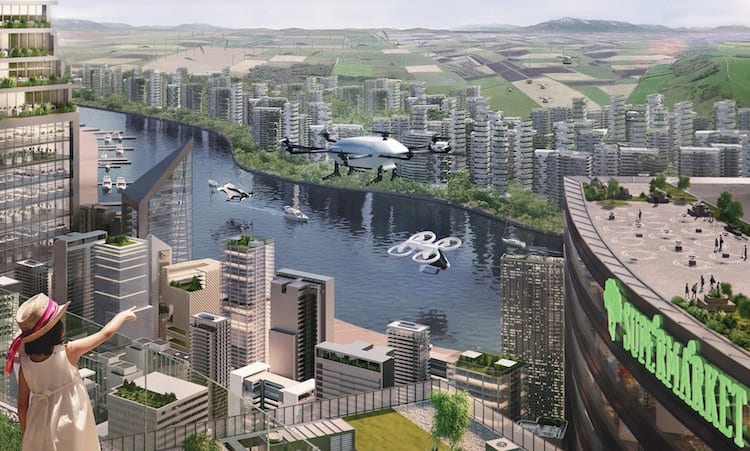
Urban air mobility concept of operations. (Airbus)
CHICAGO — The FAA wasn’t ready for drones, according to its executive director for unmanned aircraft, Jay Merkle. But the Administration learned over the last several years, and it is determined not to make the same mistake when it comes to urban air mobility (UAM).
“We’re taking a system-wide approach — that’s the biggest thing we learned from small UAS integration,” Merkle said at AUVSI Xponential 2019. “We learned that through programs and are now applying it to working with the UAM community.”
The FAA just thought about drones in terms of airworthiness or flight operations, Merkle said, not taking into account how it changed the role of a pilot, how the entire ecosystem fit together and would impact the existing airspace ecosystem — particularly at scale. With air taxis, he said, the agency is looking at airworthiness, but it’s also looking at the role of automation, of propulsion, of airspace integration and certification.
“We really think about this as, there’s an aircraft, there’s an airman and there’s airspace,” he said. “While we used to think of that individually, now we look at that holistically.”
That could be important. As big as the drone market is and could grow to be, urban air mobility, by some estimates, might alter the industry landscape to an unprecedented scale at an unprecedented rate, making it “as important in aviation as the dawn of the jet age.”
“It’s essentially like looking back over the last hundred years of aviation and trying to rebuild it in 10, 15, 20,” said Logan Jones, Boeing’s vice president of investment arm Horizon-X.
Despite those exciting outlooks, Merkle prefers not to guess.
“When we’re trying to understand where an airworthiness or operation or mission falls on the risk continuum, its best not to theorize on that,” he said. The FAA has learned not to prognosticate, he said, or risk making unsafe assumptions, which is why it’s important that the agency is in lock-step with applicants.
“That is our objective,” he said. “We’re neither lagging behind them nor trying to lead them, because I’ve seen us making mistakes on both sides.”
Typically, the FAA does its rulemaking by association, stretching and extending existing rules that most closely match the new situation rather than deliberating and declaring new rules from the ether. Drones and air taxis have created some consternation on that front: All drones are drones, but when does one go from being more like a radio-controlled hobby aircraft to a full-scale vehicle? Can those follow the same rules? Is an air taxi more like a drone or a helicopter? Which ruleset you start with for tweaks determines a lot, and some people think it’s a new market that needs entirely new rules.
Merkle disagrees.
“It is absolutely not true that there need to be all new regulations” governing UAM, he said.” “We really cracked the code on how to take decades-old aviation [rules] and get to the essence of each of those requirements and say ‘What was the safety goal here?'”
So, while a rule might require flight manuals onboard on aircraft — which would do no good if the pilot is flying the aircraft from a remote ground station — the FAA is now comfortable upholding the spirit of the rule instead of the letter.
“We found out through Part 23, we can really bring an aircraft through the process and address all the concerns,” Merkle said. “The best news is with airspace.”
Most of the new aircraft are “operating like” instrument-flight-rules or visual-flight-rules aircraft and, in many cases, “are really electric or hybrid-electric helicopters,” according to Merkle, which provides an established template and simplifies the job of integrating them into the National Airspace System.
While many in the industry are, not everybody is as bullish as the FAA.
“Our timeline is very similar to [NASA’s more conservative estimates, which questions the mid-2020s launch date] said Michael Blades, vice president of the Americas, aerospace, defense and security at consulting firm Frost & Sullivan. “How many have had something delivered to your house from Amazon? How many have had it delivered by drone? Nobody, right? They promised this 6 years ago. We try to look at it realistically.”
Really, though, the FAA’s focus is that it doesn’t slow down the timeline, which Merkle admits it had started to do until recently, when the drone market served as a wakeup call, and the administration wasn’t prepared to certify them or integrate them into the NAS.
“The NAS, for over a hundred years, has been constantly evolving,” Merkle said. “I think we saw, probably up until about 5 years ago, the thing the FAA had lost its practice in was large-scale transformation with new entrants. It had been slow evolution for about two decades. And with small UAS, the FAA was caught off guard, really, for both regulation and infrastructure. But it caught up and now ready for UAM, and actively engaged with the community.”
And now that it is caught up, Merkle is confident as long as the agency focuses on the present.
“Please don’t ask to predict things,” he said. “We’re just horrible at it.”